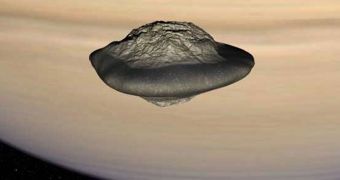Since the diminutive moons Atlas and Pan were discovered around Saturn, experts have wondered about how they formed. The conclusions of a recent investigation clear up the mystery, proposing that the two objects were formed through the aggregation of icy particles.
What separates these two moons from the rest of Saturn's companions – in addition to their size – is the fact that they have irregular shapes. In all fairness, they look strikingly similar to flying saucers.
They were both discovered using the Cassini orbiter, which arrived at the gas giant on July 1, 2004. Since them, it has spent all of its time investigating the planet, its rings and its complex moon system.
The spacecraft found Pan in the Encke Gap of the A Ring around Saturn. It is the closest one to the planet, and is officially described as being walnut-shaped. Astronomers have since hypothesized that the object is responsible for the very existence of the Encke Gap.
Featuring a diameter of 35 kilometers, and a height of 23, Pan is believed to be the collecter of particles that stray from the A Ring into the Encke Gap. Its shape cannot be explained in other ways.
When the object was first found, scientists looked at it in disbelief, because it should have been spherical, yet it was not. Rather, it had the appearance that other moons have when they spin around their planets at very high speeds.
Yet Pan is not spinning around Saturn at even a fraction of the necessary speed for it to be deformed in this manner. According to experts at the Boulder, Colorado-based Space Science Institute (SSI), its walnut shape can be explained if we consider it accumulates particles from the A Ring.
SSI planetary scientist Carolyn Porco says that it's highly unlikely Pan or Atlas are the products of a larger moon that was destroyed during a space impact. The hypothesis is detailed in a paper that appeared in the December 6, 2010 issue of the top journal Science, Daily Galaxy reports.
The latest Cassini data have validated the SSI theory, showing that the two objects are in fact icy bodies, that are tremendously light, and also very porous. In fact, their composition matches that of the particles making up the rings in which they spin almost identically.
These results could provide planetary scientists with an advanced insight into the processes that may have went on when our planet was formed from the protoplanetary disk surrounding the Sun after the star was formed.
This structure features vast amounts of hydrogen gas and cosmic dust, which aggregated to form all the planets in the solar system. The process is still not very well understood, but perhaps studying Pan and Atlas may provide the break astronomers have been waiting for.

 14 DAY TRIAL //
14 DAY TRIAL //